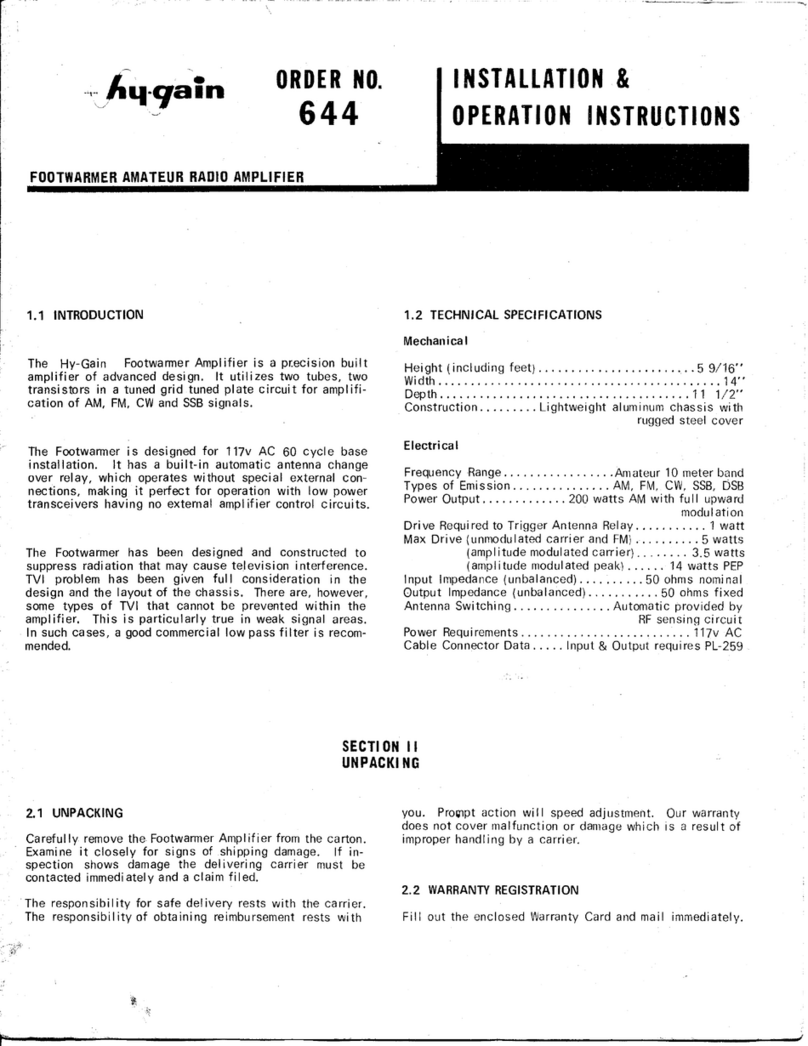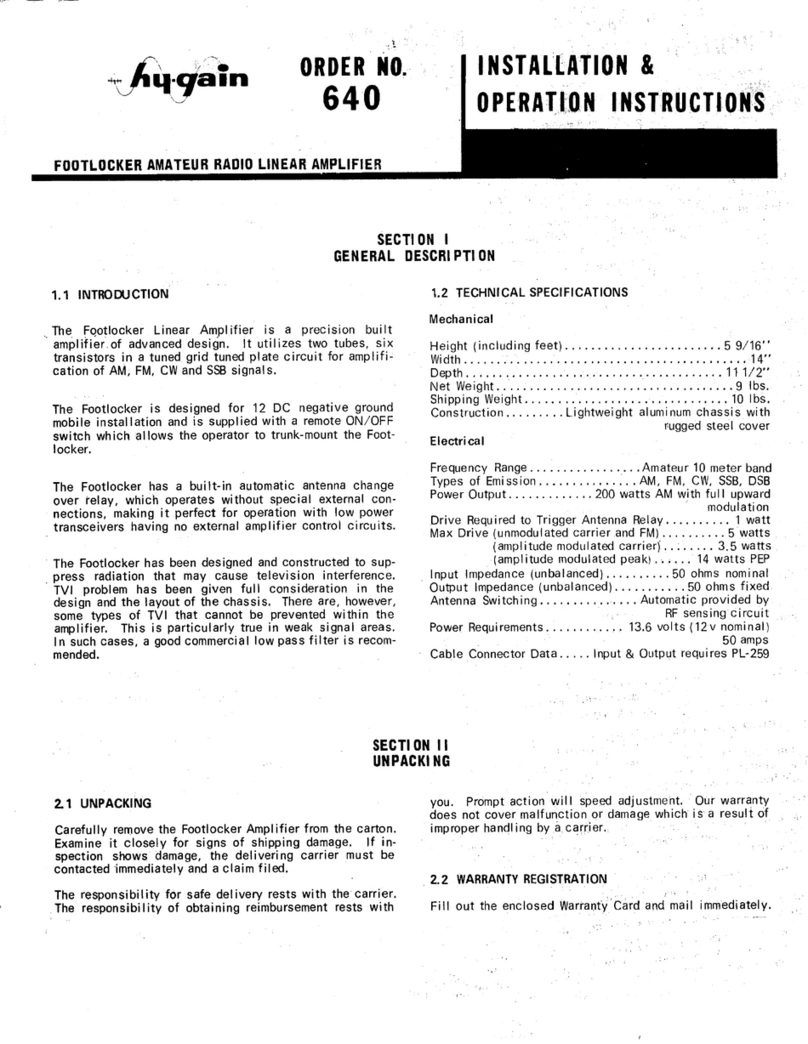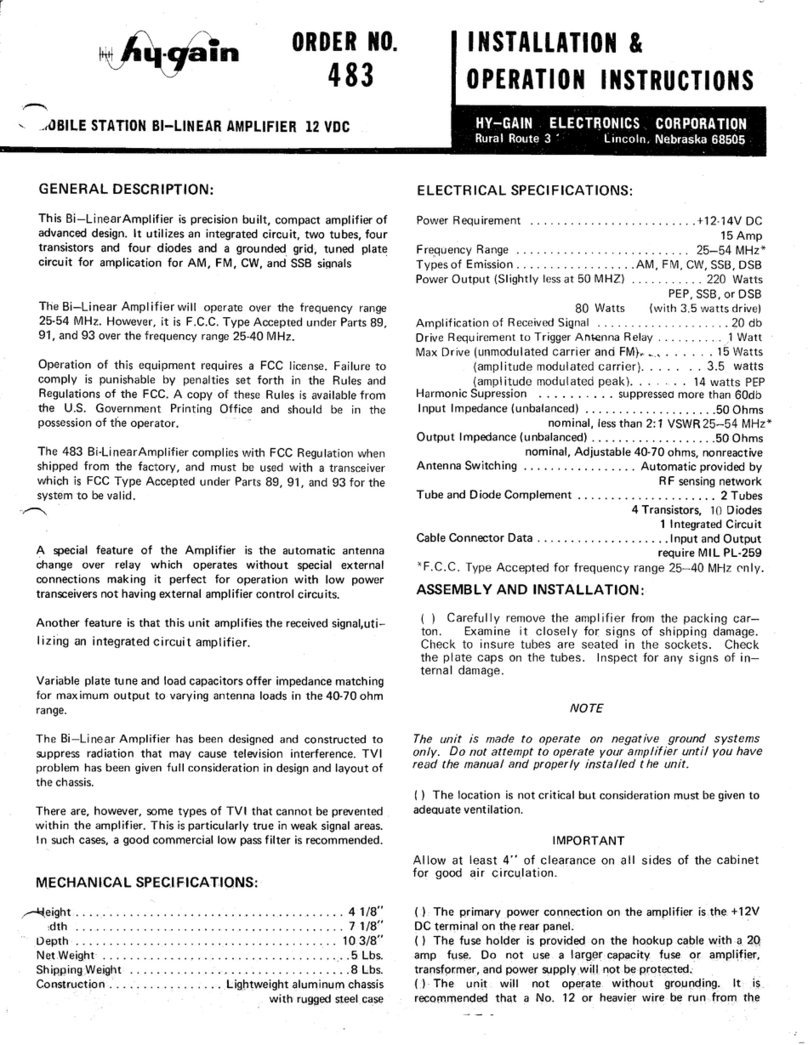ORDER NO.
48
i~
BASE STATION LINEAR AMPLIFIER 115 VAC
I NSTALLATION
OPERATION INSTRUCTIONS
HV-GAIN ELECTRONICS CORPORATION
Rural Route3 lincoln. Nebraska 68505
This linear amplifier is a precision built, compact, high output
amplifier of advanced design. It utilizes two tubes, two transistors
and three diodes in a grounded grid, tuned plate circuit for
amplification of AM, FM, CW and SSB signals
The 480 Linear Amplifier will operate over the frequency range
25-54 MHz. However, it is F.C.C. Type Accepted under Parts 89,
91, and 93 over the frequency range 25-40 MHz.
Operation of this equipment requires a FCC license. Failure to
comply is punishable by penalities set forth in the Rules and
Regulations of the FCC. A copy of the Rules is available from the
U.S. Government Printing Office and should be in the possession
of the operator.
This model Linear Amplifier complies with FCC regulation when
shipped from the factory. and must be used with a transceiver
which is FCC Type Accepted under Parts 89, 91, and 93 for the
system to be valid.
A special feature of this linear amplifier is the automatic antenna
change over relay which operates without special external
connections making it perfect for operation with low power
transceivers not having external amplifier control circuits.
Variable plate tune and load capacitors offer impedance matching
for maximum output to varying antenna loads, in the 40 to 70
ohm range.
The front panel indicator lights provide reliable visual indications
of proper amplifier operation without complicated metering
circuits.
The linear amplifier has been designed and construGted to
suppress spurious radiation that may cause television interference.
The TVI problem was given full consideration in design and
layout of the chassis.
There are, however, some types of TVI that cannot be prevented
within the amplifier. This particularly true in weak signal areas. In
such cases, a good commercial low-pass filter is recommended.
Height 4 1/8
Width 7 1/8
Depth
103/8
,,-., Net Weight 11 Pounds
Shipping Weight 12 Pounds
Construction Light weight aluminum chassis
with rugged steel case
Power Requirements 120 VAC/3 amps
Frequency Range 25-54 MHz*
Types of Emission AM, FM, CW, SSB, DSB
Power Output (ave.).Slightly less at 50 MHz 220 Watts
PEP, minimum 80 watts carrier
Drive Requirement for Rated Carrier Output 3.5 Watts
Drive Requirement to Trigger Antenna Relay 1 Watt
Max Drive (unmodulated carrier and FM) 15 Watts
(amplitude modulated carrier) 3.5 watts
(amplitude modulated peak) ,14 watts PEP
Harmonic Supression suppressed more than 60 db
Input Impedance (unbalanced) 50 Ohms
nominal, less than 2: 1 VSWR 25-54 MHz*
Output Impedance (unbalanced) 50 Ohms
nominal, Adjustable 40·70 ohms, non-reactive
Antenna Switching Automatic provided by RF
sensing network
Tube and Diode Complement .. 2 Tubes, 2 Transistors, 3 Diodes
Cable Connector Data Input and output require
MIL PL-259
*F.C.C. Type Accepted for frequency range 25-40 MHz only
Carefully remove the Linear Amplifier from the packing carton.
Examine it closely for signs of shipping damage. Remove the four
screws holding the top cabinet and remove all hold down tape
and packing materials. Check to insure tubes are seated in the
sockets. Install the plate caps on the tubes and the fuse in the
holder. Inspect for any signs of internal damage.
Do not attempt to operate your Linear Amplifier or make any
connections until you have read this entire manual and
understand your amplifier fully.
The location is not critical but care should be taken to insure
adequate ventilation.
DO NOT SET ANY EQUIPMENT ON TOP OF THE CASE OR
COVER THE AMPLIFIER WITH BOOKS, PAPERS, ETC., OR
OVERHEATING WILL RESULT. ALLOW AT LEAST FOUR
U\lCHES OF CLEARANCE ON ALL SIDES OF THE CABINET
FOR GOOD AIR CIRCULATION.































